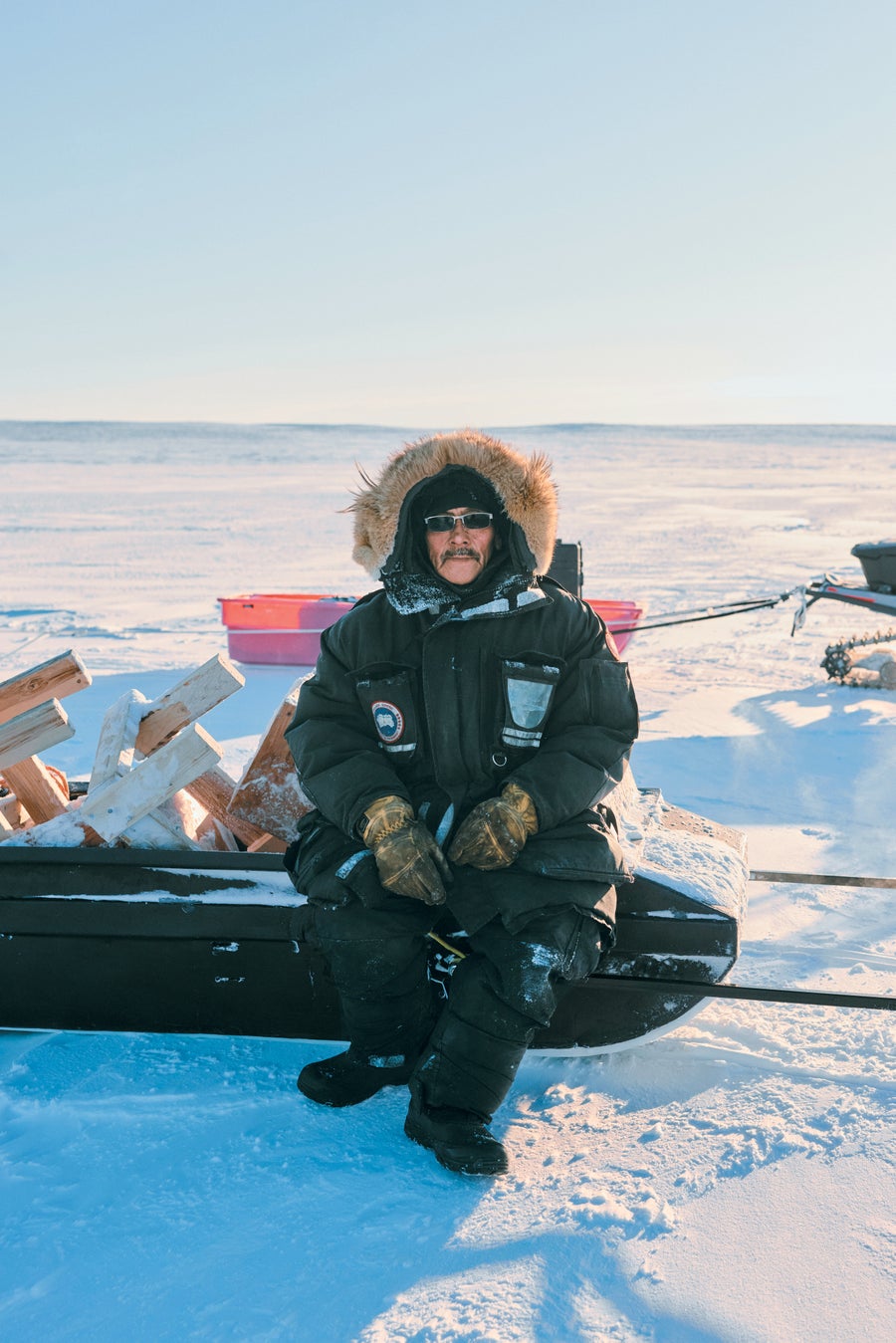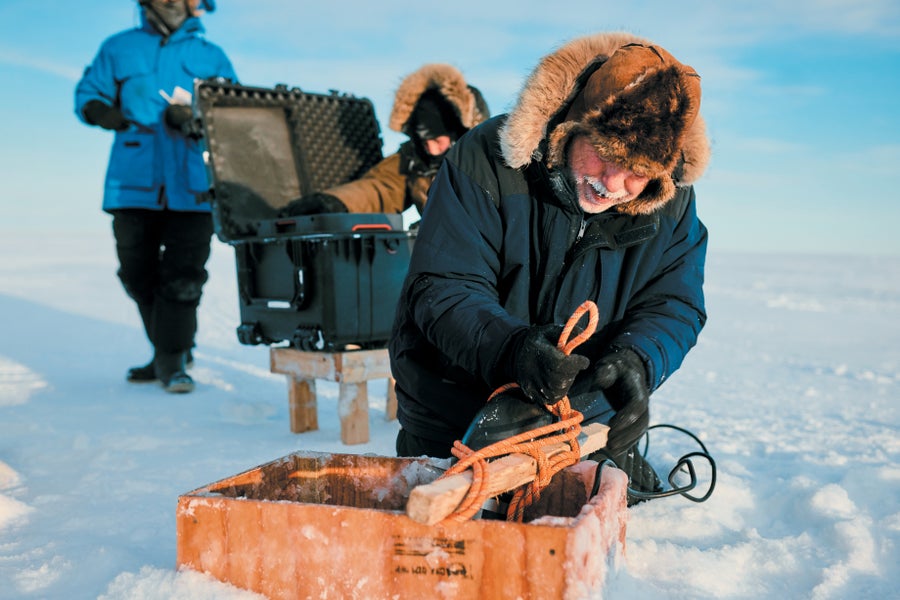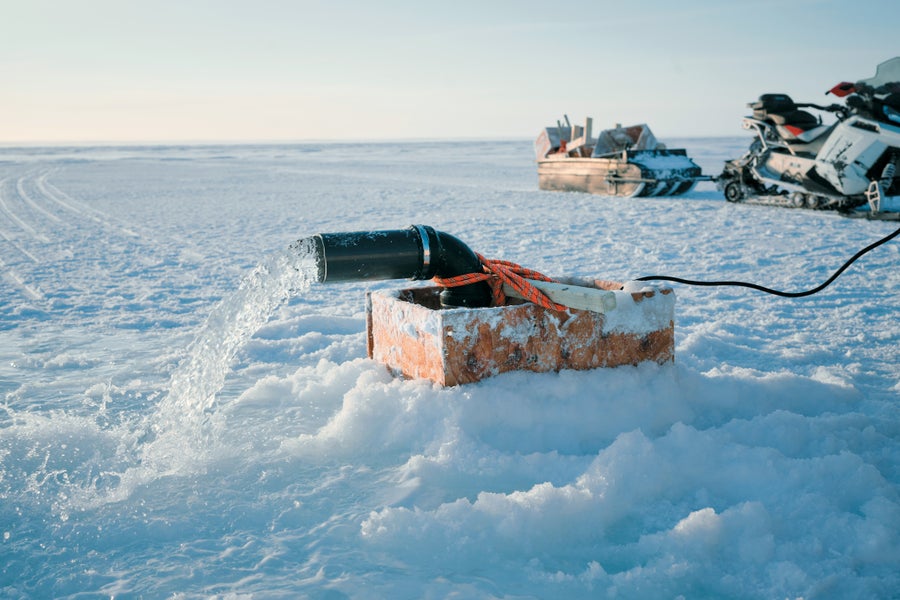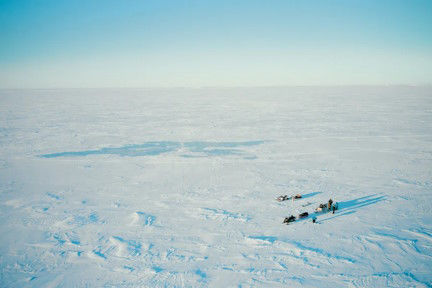Part 2 of 3.
continuing from a previous article...
After the team drilled the first hole that February morning and started the pump, we snowmobiled to a destination pinpointed by GPS several hundred meters away. Again the group drilled and inserted a pump, and water began whooshing out. In all, we installed four pumps in four places. As water pooled, the edges crept outward, soaking into the pockmarked snow, which was up to 25 centimeters (10 inches) thick and crusty like hardened white frosting. Within hours the pool would coagulate into electric-blue slush, like a gas station Slurpee.
After a lunch of fruit bars and potato chips around a tiny gas heater in the team’s rescue tent, we went to a site the crew had pumped a day earlier. Under a dusting of snow lay flat gray ice. With a drill bit almost as tall as himself, one of the volunteers bored a hole and dropped in a measuring tape with fold-out brass arms at its end. The ice was 152 centimeters thick; almost 30 centimeters of ice had been added, compared with untouched sites they measured.

(Inuit hunter David Kavanna guides the team to prospective sites seven kilometers away from Cambridge Bay. Taylor Roades)
The ice would thicken further in coming weeks. Because snow is a better insulator than ice—this quality is why igloos work so well—flooding and freezing the snow could allow more cold to penetrate to the ice’s underside, creating more ice. After Real Ice thickened 4,100 square meters of ice here in winter 2023–2024, the crew came back in May 2024 to find a significant increase. Across the area they had pumped, ice thickness was 1.9 meters, compared with 1.44 meters in other places. “Ice growth from below—that’s the really efficient part,” Woods told me as he drilled a measuring hole at another refrozen site.
But snow is also a better mirror than ice, which could complicate the picture. Sea ice covered by snow reflects 90 percent of solar radiation, whereas bare sea ice reflects 50 to 70 percent. Real Ice would need snow to accumulate in spring to replenish the snow it flooded in winter, or the process could increase melting.
That’s just one way flooding snow could backfire. As seawater freezes, the salt in it is ejected from the ice crystals, leading ever saltier pockets of brine to form on the surface. Salt lowers the freezing point of ice, whether on winter roads or the sea. If pumping seawater leaves more salt on the surface in summertime, it could end up accelerating the disappearance of the ice.
So far this doesn’t seem to be happening. On another morning Woods put a hollow red barrel on the drill and bored into the ice at a refrozen site to extract an ice core about as long and thick as his arm. He held it up to the pale sun, which illuminated hairline channels where the salty fluid had eaten its way through the ice. “This natural process helps the brine to migrate back into the ocean,” he said.
It’s still not clear how ice thickening will affect sea life, starting with the microscopic algae that grow on the underside of the ice. They’re eaten by zooplankton, which are eaten by fish, which are eaten by mammals. On a different morning I snowmobiled with University of Alaska Fairbanks marine biologist Brendan Kelly to a low ridge formed by two enormous plates of ice pushing together. A polar science adviser in President Barack Obama’s administration, Kelly has studied seals and polar bears for more than four decades. In that time he’s also watched fossil-fuel emissions march steadily upward. So despite his discomfort with geoengineering, he agreed to advise Real Ice.

(Biologist Brendan Kelly ties a water pump to a wood box erected around a hole in the ice. Taylor Roades)
In the hazy light, the monochrome landscape seemed devoid of life. But as we crunched on foot along the snow caking the ridge, Kelly stopped to point out an Arctic fox footprint. Farther on he found a urine stain, then desiccated green scat, then a small pit. “Seal, probably,” Kelly said. In spring, ringed seals claw holes through snowdrifts. They hide their fuzzy white pups in these lairs while they dive for fish and crustaceans. Foxes and polar bears dig around to try to find the pups. Kelly scooped at the firm snow, tiny icicles swaying from his white mustache, but couldn’t find a lair.
Polar bears also depend on snow. They excavate dens in larger drifts to warm their cubs, which are born the size of a guinea pig. Most Arctic snow tends to fall in late autumn. It’s unknown whether enough new snow would build up after wintertime ice thickening for bears and seals to make dens in spring. Of course, polar bears and seals are already expected to decline as their sea-ice habitat melts away. Is Real Ice doing more harm than good by pumping seawater into this environment, melting the snow? “We don’t know that,” Kelly said. “But we need to know it.”
Across two months last winter, Real Ice pumped water through almost 200 holes. Drills and snowmobiles broke, team members got frostnip, and Arctic foxes chewed through long, thin thermistor cables used to measure temperature in the snow and ice. The researchers thickened 250,000 square meters of sea ice. The ice cap is losing 300,000 times that area every year.
The key to scaling up is to “bring the engineering underwater,” Sherwin told me later. The Sant’Anna School of Advanced Studies in Pisa, Italy, is developing an underwater drone two meters long that will bore through ice from below with a heated pipe and start pumping water up through it. In renderings, it looks like a folding pocketknife with a pipe instead of a blade. Real Ice hopes to test a prototype this year, says co-CEO Andrea Ceccolini, an Italian computer scientist and investor who joined the company in 2022.
The plan is to thicken 100 square kilometers of sea ice in winter 2027–2028 to demonstrate the technique to governments and investors. The approach verges on the fantastic. A swarm of 50 drones would melt holes in minutes and pump water as their infrared cameras monitored the progress. Technicians on a floating or onshore hub would swap out the drones’ batteries, plugging the old ones into chargers powered by wind turbines or by green hydrogen or ammonia brought in by ship. Tapping into electricity from Canada’s Nunavut region would contribute to climate change because most of it is generated from diesel fuel.
The ultimate goal of thickening one million square kilometers of sea ice would take an estimated 500,000 drones, which would consume two terawatt-hours of electricity and require 20,000 people to service them, according to rough math Ceccolini has done. The cost would be $10 billion annually. The drones would vastly exceed the 3,800 Argo robot sensors circulating in oceans worldwide, and drone experts say a revolution in battery technology would be needed.

(A pump, powered by batteries, pours seawater from under the ice onto the surface, where it floods snow and makes new ice, thickening the sheet so it will last longer in the coming summer's sun. Taylor Roades)
How much global warming could be countered through sea-ice preservation depends on numerous variables affecting sunlight and melt dynamics. Preserving a million square kilometers of sea ice for one additional summer month would cool Earth as much as removing 930 million metric tons of carbon dioxide from the atmosphere over 20 years, Real Ice estimates. For these results, $10 billion is actually cheap, Ceccolini says, and the cooling would be immediate. Capturing that much CO2 from the air with existing machines would currently cost at least $465 billion. For perspective, humanity emits 910 million tons of CO2 every eight days, with no end in sight. Thickening sea ice is a Band-Aid “while you cure the patient—the planet—properly,” Ceccolini says.
Every day in Cambridge Bay, after three or four hours of flooding, the team used an ice ax to hack each pump out of its hole. Fat white frost flowers formed on top of the solidifying surface. The speed of the freeze was striking—but so was the immensity of the frozen plain stretching to the horizon. It was hard to envision hundreds of thousands of drones popping through the ice day after day, all winter long, for decades.
To be continued...











